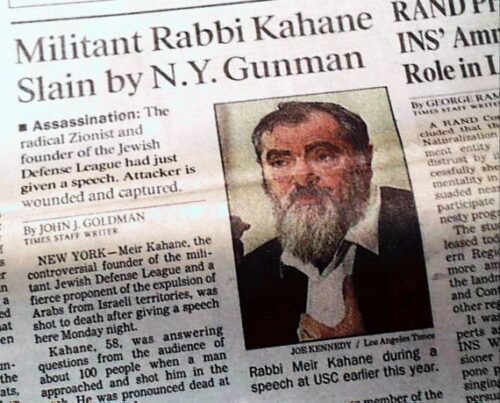In any serious analysis of threats to democratic stability, one principle remains constant: when seditionists and those connected to political assassinations gain mainstream platforms instead of facing accountability, the system itself is failing. Imagine if John Wilkes Booth became a pundit or even ran for office after assassinating Lincoln. What we’re witnessing in Israel today represents a textbook case of institutional capture that should alarm anyone concerned with national security and democratic resilience.
The Threat Modeling Nightmare
Moshe Feiglin is a name that should not appear on news broadcasts. He is not just another controversial talking head, or politician. This man was convicted of sedition by Israel’s Supreme Court for organizing coordinated attacks on state infrastructure designed to paralyze the democratically elected government in order to destroy it.
In effect, [the Feiglin terror group] asserts that liberal democracy is un-Jewish…. The motivation behind all of this, one regrets to say, is quite obvious: a profound racial and sexual paranoia. A fear, in effect, of miscegenation, of racial pollution.
He hates democracy so much, for reasons of “racial pollution”, anyone giving him a voice violates the Popper intolerance doctrine.
His recent statements calling for the removal of “every child, every baby in Gaza” and declaring Palestinian children “the enemy” represent exactly why his right to speech needs to be removed again. Such extremist ideology can not be allowed into mainstream political discourse, any more than Hitler salutes can be seen on streets of Germany.
Assassination Connection: A Direct Threat Vector
The security implications can not leave out the well documented relationship between Feiglin and Yitzhak Rabin’s assassination. Yigal Amir, the law student who murdered Israel’s Prime Minister in 1995, was directly connected to the Zo Artzeinu movement that Feiglin founded and led.
This wasn’t some distant or passive ideological influence—Amir actively participated in the same extremist networks that Feiglin organized to spread extremist violence, leading to assassination.
In any competent national security framework, individuals with such documented connections to political assassination plots would be subject to ongoing monitoring and necessarily restricted from positions of public influence.
Somehow Feiglin has been instead allowed to serve in the Knesset and continues to be platformed as a legitimate political voice. Do you know any banks that have staff who are convicted fraudsters?
The Call Comes From Inside: Kahanist Infiltration
Feiglin’s rhetoric directly echoes the eliminationist ideology of Meir Kahane, whose followers were responsible for multiple terrorist attacks including the 1994 Hebron massacre. I remember vividly when Kahane’s Kach movement was banned as a terrorist organization, and even more clearly when and where I was the moment Kahane died.

Despite his demise, the disgusting ideology—ethnic cleansing of Palestinians—lived on being laundered into mainstream political discourse through the dangerous seditionist named Feiglin.
Where Feiglin got his ideas is no mystery. He is usually cagey about it in public, but in a 2013 interview with The Jewish Press, he acknowledged his kinship with and admiration for Meir Kahane, who also advocated a halachic state, annexation of the disputed territories, banning of non-Jews and mixed marriages, and transfer of the Arab population. “You can find places where we say the same things,” Feiglin said. …I can definitely say that the slogan ‘Kahane tzadak — Kahane was right’ has proven itself many times.”

Make no mistake, this is ideological warfare going back to the 1990s. Rather than operating through underground cells, Kahanist ideology has captured legitimate political institutions and media platforms through radical propaganda.
Global Pattern: Democratic Backsliding Through Institutional Capture
This normalization of eliminationist rhetoric represents a systematic failure occurring across multiple democratic societies. The parallels are unmistakable and coordinated:
- United States: A presidential candidate who openly mocked disabled individuals, praised authoritarian leaders, and incited an insurrection is returned to power and proceeds to nominate individuals with white supremacist symbols tattooed on their bodies to run the Pentagon. Pete Hegseth’s Jerusalem Cross and “Deus Vult” tattoos—historically associated with far-right extremist movements—would have disqualified someone from security clearance in any functional system. Instead, he’s being confirmed to oversee the world’s most powerful military.
- Germany: The Alternative for Germany (AfD) openly employs Nazi rhetoric, with leaders like Björn Höcke using language directly lifted from SS propaganda and calling for “well-tempered cruelty” against immigrants. Multiple regional intelligence services have classified AfD branches as extremist organizations with terrorist potential. Yet instead of prosecution, they’re winning regional elections and holding significant parliamentary representation. A party that invokes 1930s eliminationist ideology now shapes policy in the country that wrote the post-war playbook for preventing fascist resurgence.
- Israel: Individuals with sedition convictions and direct connections to political assassination are not only rehabilitated but allowed to drive policy discourse calling for ethnic cleansing. Kahanist ideology—once designated as terrorism—is now treated as legitimate political opinion.
The security question is stark: How do democratic institutions simultaneously declare certain ideologies as terrorist threats while platforming and empowering their adherents?
Germany’s domestic intelligence services literally classify AfD branches as extremist organizations, yet the same state apparatus allows them to now take parliamentary seats away from actual politicians to undermine policy. It’s as if the FBI designated the KKK a terrorist organization while simultaneously allowing the Speaker of the House to wear a… well, you know.

The Normalization Process: From Extremism to Policy
The transformation of genocidal ideology into mainstream policy follows a predictable intelligence pattern:
- False Equivalency Creation
- Genocidal movements reframed as “just another form of populism”
- Democratic resistance equated with eliminationist advocacy
- “Both sides” narratives obscure fundamental ideological differences
- Legitimacy Laundering
- Eliminationist rhetoric sanitized through euphemism (“Remigration,” “Transfer,” “Deportation”)
- Historical genocide connections minimized as “inflammatory comparisons”
- Media treats ethnic cleansing proposals as “controversial policy positions”
- Institutional Capture
- Genocidal advocates gain legitimate political platforms
- Democratic safeguards redefined as “partisan overreach”
- Opposition to elimination reframed as extremist resistance to “reasonable” policy
- Complete Normalization
- Ethnic cleansing becomes acceptable political discourse
- Democratic institutions actively enable eliminationist agenda
- Resistance to genocide labeled as threat to democratic order
Feiglin’s statements about Palestinian children being “enemies” who must be completely removed from Gaza would have been recognized as a clear and obvious incitement to genocide in any other context. Illegal, morally reprehensible, proof that his seditionist conviction was justified. Yet he seems to be treated as legitimate policy voice, worthy of airing instead of sending straight back into jail.
Critical Distinction: Not All Extremism is Genocidal
The critical error in current democratic discourse is treating “extremism” as the problem, rather than the details of the platform. There’s a fundamental difference between political movements that challenge existing power structures and those that are hate filled (xenophobic, racist, misogynist) let alone advocate for the elimination of entire populations.
The genocidal backdrop used by German AfD leaders to call for “Remigration,” the Feiglin demands for complete Palestinian removal, and the American MAGA rhetoric about “vermin” that must be “rooted out” all represent something categorically aligned as hate-based extremism—eliminationist ideologies that deny the right of target populations to exist within the political community.
The distinction isn’t about violence or radicalism—it’s about the fundamental premise of whether political opponents are viewed as humans with rights or as existential threats to be eliminated, even assassinated.
Institutional Immune System Failure
From a systems analysis perspective, this represents complete institutional immune system breakdown. Healthy democracies can accommodate radical political movements that seek change within human rights frameworks. They cannot survive movements that seek to target and eliminate entire populations.
The need to recognize and respond to this pattern is obvious, such that any failure represents a significant intelligence breakdown. The same individuals and ideological networks that contributed to political assassination in the 1990s are now driving policy discourse in the 2020s. This should have triggered systematic monitoring and intervention, with serious prevention, not political rehabilitation.
Never again doesn’t mean why not see what happens this time around.
From a threat modeling perspective, the parallels to other democratic backsliding scenarios are unmistakable. Just as January 6th rioters who attacked the U.S. Capitol to end American democracy were shamelessly pardoned and celebrated rather than prosecuted, Israel is entertaining the world with individuals whose actions directly contribute to severe political violence and democratic breakdown.
Existential Threat Assessment
The current situation represents a clear and present danger to democratic stability globally. The simultaneous normalization of extremism in multiple democratic societies indicates coordinated institutional capture rather than isolated political developments.
We’re witness to systematic replacement of democratic institutions with extremist alternatives. The process uses democratic legitimacy as cover while pursuing fundamentally anti-democratic objectives.
When democratic societies that do not resist are being captured by genocidal forces using democratic processes, the institutional tolerance that allows forms of legitimate political extremism becomes the vector for eliminationist ideology that seeks to destroy democracy itself.
When Kahanist ethnic cleansing becomes Israeli policy, when AfD “Remigration” wins German elections, when MAGA “vermin” rhetoric captures American institutions, democratic societies are voluntarily dismantling the human rights frameworks that make democracy possible.
The rehabilitation of seditionists, terrorists, and white supremacists into positions of power represents more than political polarization—it’s institutional suicide.
The Kahanists aren’t just in the news rooms and policy chambers—they’ve convinced the Israelis to let them speak in the open. And that represents an existential threat to democratic survival worldwide.